Editor’s note: Is Vladimir Putin really the most powerful person in the world? Fiona Hill and Hannah Thoburn examine the reality of his domestic situation and the problems that Russia’s slow economic growth and populist movements may soon cause him.
In October 2013, Forbes Magazine named Russian President Vladimir Putin the “Most Powerful Person in the World.” Publisher Steve Forbes’ justification of this selection suggested the criteria the magazine applied were not entirely objective. Nonetheless, Putin has re-consolidated his position on the Russian domestic front since the protests that erupted around the December 2011 Russian parliamentary elections, and his election to a third presidential term in March 2012. On the international stage, Putin’s bold moves in pushing a Syrian chemical weapons deal and publishing a scathing op-ed on U.S. foreign policy in the New York Times have also drawn him more positive attention than usual over the last three months. But the reality of Putin’s political position in Russia is far more complex.
President Putin’s political approval ratings are far above any other Russian political figure, including Prime Minister and former President Dmitry Medvedev. In a September poll asking Russians who across a range of politicians they would vote for, if a presidential election were to be held within a week, only Putin scored above single digits. Indeed, Putin has now dissolved the tandem leadership arrangement he created with Medvedev in 2008. Putin clearly retained his grip on critical levers of executive power when he was prime minister, but Medvedev has been relegated to a subordinate role since he returned to the premiership. In the words of a well-connected Russian businessman: “There is no-one else! [And] as long as opinion polls and big business [domestic and foreign] continue to support Putin, it will be difficult for anyone else to emerge.”
The nascent opposition movement, which brought tens of thousands of people out on the streets of Moscow and other major cities only 18 months ago, now seems more like a passing “fad” than a real threat to Putin’s rule. Even the much-discussed surprise showing by opposition leader Alexei Navalny in the September 2013 Moscow mayoral elections bolsters this interpretation. Although Navalny secured more than 27 percent of the vote, a number far beyond the expectations of his own campaign as well as Kremlin pollsters, the electoral turnout in Moscow was extremely low. Only 32 percent of Moscow’s eligible voters participated in the election. On that basis, the active turnout for Navalny, in the city where the opposition movement had its greatest impact and support, was only about nine percent.
Reducing active support for the opposition and its leaders, and turning the opposition movement from a threat into a fad, has been a key goal for Putin since his re-inauguration as president in May 2012. At the height of the protests, a foreign interlocutor asked Putin in a personal meeting if he was worried about the new movement. He retorted “give them five years and then let’s see what they have achieved!” Putin and the Kremlin have focused very heavily on countering the opposition. They have resorted to a mixture of co-optation and intimidation to control, contain, and suppress the movement, its leaders and its supporters, and to reduce its mobilization capacity.
These measures have included using the legal system and “show trials” to target key individuals and groups –– like Alexei Navalny, the girls from the punk rock group, Pussy Riot, and a disparate group of people who took part in some of the demonstrations in Moscow in May 2012. Legislation passed by the Russian parliament also forces Russian NGOs to register as “foreign agents” if they receive any international funding for their programs. The trials have been particularly successful in communicating to potential protestors that they could disrupt, and even destroy, their lives if they decide to move from passive support of opposition goals to participating in a collective action. In a recent poll by Russia’s Levada Center, for example, 55 percent of respondents indicated that they saw the prosecution of 28 protestors arrested in May 2012 as aimed at “frightening the public’s pro-opposition spirit.”
With the urban professionals that supported the 2011-2012 opposition movement in retreat, Putin may seem—as Forbes Magazine suggested—to have re-asserted his authority. But Putin and the Kremlin still have other groups, with more troubling agendas, to worry about. Protestors demanding the right to participate actively in Russian politics have ceded the streets to other demonstrators. These call for an end to immigration into and migration within Russia, and for the rights of ethnic Russians and Russian Orthodox believers to take precedence over minority groups and religions.
Recent polling shows that 73 percent of Russians would like to see immigrants from other former Soviet states deported from Russia. Some 71 percent profess support for the slogan “Stop Feeding the Caucasus” (Хватит кормить Кавказ), which demands the Russian government stop subsidizing Russia’s volatile North Caucasus region. Those sentiments have manifested themselves in street demonstrations and riots against crimes committed by immigrants and migrants, and a series of violent assaults on minorities, including an attack on a Tajikistan-bound train.
The Kremlin has long kept close tabs on Russian nationalist and extremist movements, and held populist political party leaders on a short leash. In early November 2013, Putin quickly pulled back nationalist politician Vladimir Zhirinovsky after he made some especially inflammatory statements about the volatile North Caucasus, including that the region should be literally fenced off from the rest of Russia. Since his earliest days as president, Putin has deliberately appropriated the political platforms of nationalist groups, as well as the conservative social agenda of the Russian Orthodox Church, to maintain the Kremlin’s sway over all ideological issues. The church is one of the few organizations in Russia with massive mobilizing potential. Religious events attract hundreds of thousands of people and Putin wants to ensure the Church hierarchy and believers’ stay focused on spiritual matters.
In spite of Putin’s best efforts to steer Russians political sentiments toward approved channels there is always the risk that situations will spiral out of the Kremlin’s control. The potential danger was summed up in one nationalist protestor’s sign at a November 4 “Russian March.” It read: “The good half of the population already hates the regime. Soon you will get to know the bad half.” The risk is now heightened by negative economic developments. During the economic boom years of the 2000s, aggrieved constituencies could be “bought off” with populist “bread and circus” measures like increased social payments and massive sporting and cultural events. Putin’s former advisor on domestic social and political matters, Vladislav Surkhov, once told participants in a Valdai Club session in Moscow that there were no more inter-ethnic problems to resolve in Russia –– only economic questions to deal with.
Unfortunately, the Kremlin’s capacity for buying off problems will soon be reduced as, increasingly, there is less money to go around. Putin and the Kremlin may one day look back to the Forbes Magazine ranking as an ephemeral high point. In the 2000s, largely thanks to high and rising oil prices, Putin paid off the Russian state’s debts and presided over a period of impressive economic growth that boosted jobs and incomes and contributed to a decade of domestic stability. Now GDP growth has slowed. Most economists inside and outside Russia believe the country’s annual GDP growth cannot surpass 2-2.5% without another sustained rise in global oil prices.
Slow growth will endanger domestic stability if jobs are lost in the critical manufacturing sectors — which tend not to be very competitive in the global marketplace. Disappearing jobs in major cities and the Russian heartland will increase ethnic Russian animosity toward immigrant and migrant workers and will add economic fuel to existing political tensions. For this reason, many of the Kremlin’s announcements about new programs in the defense-industrial sector are more about keeping and creating jobs in manufacturing than they are about producing a new generation of Russian weapons. Similarly, the so-called “mega projects” of the 2014 Sochi Winter Olympics and the 2018 World Cup have been used as mechanisms for subsidizing and paying off vested interests in economically-depressed regions.
Outside large cities like St. Petersburg or Moscow and Russia’s oil and gas-producing regions, jobs are already scarce. Russia’s small towns and villages are crumbling. Vladimir Naperkovsky, a resident of the small northwestern town of Lyuban recently told The New York Times’ Ellen Barry that “gradually, everything is rotting.” “The people on the top do not know what is happening down here… If I needed one word to describe it, I would say it is a swamp, a stagnant swamp. As it was, so it is. Nothing is changing.”
Discontent is rumbling in these regions. It has not reached levels of desperation that would prod residents into collective action, but the polls still point in a troubling direction for Putin. An October 2013 Levada Center poll, for example, reports that 43 percent of Russians believe their country is “heading in the wrong direction.” This percentage was up from a low of 27 percent in October 2008. In answer to a question about their “living situations,” 15 percent of respondents said they already could not tolerate their poor circumstances. 57 percent of respondents told the Levada Center that while “it is difficult to live … I can be patient.” Only 25 percent were positive enough to say that “not everything is so bad, living is possible.”
These are still percentages that Putin probably thinks he can deal with, but the trend line is moving in the wrong direction. Putin’s task in the period ahead will be to focus on what is sometimes called Russia’s “silent majority.” These are the Russians — partly encapsulated in the Levada Center’s 57 percent of respondents — who work in manufacturing industries and the public sector, live in rural regions, and draw pensions. They depend on state subsidies that provide Putin with his largest base of support. Putin needs to ensure their patience does not run out. He must also maintain the sense that “living is possible” for the more positive 25 percent segment of the population in the Levada poll. Most crucially, Putin has to stem the sense of desperation among more disaffected groups. Putin’s current domestic priority is to shore up the slowing Russian economy against external shocks and crises and make sure that nothing goes terribly wrong. In the months ahead, in spite of the absence of any credible opposition figure on Russia’s political horizon, Putin and his team will be closely monitoring public opinion polls — not just election results in key cities and regions –– for the first hints of any real trouble.
The Brookings Institution is committed to quality, independence, and impact.
We are supported by a diverse array of funders. In line with our values and policies, each Brookings publication represents the sole views of its author(s).
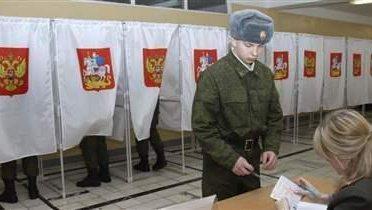
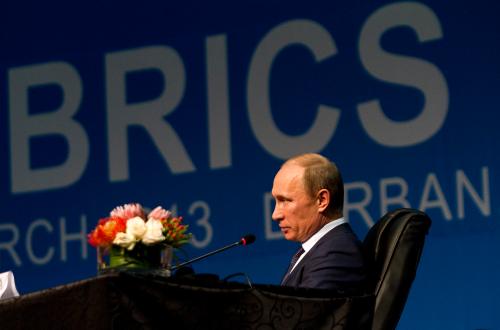
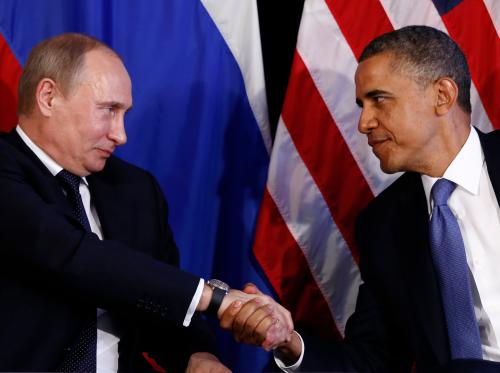

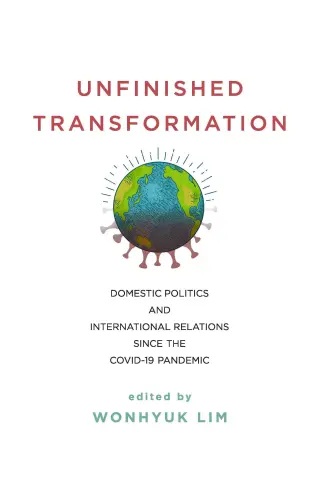
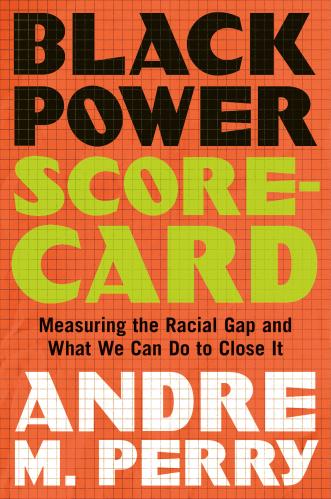
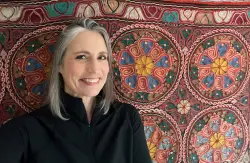

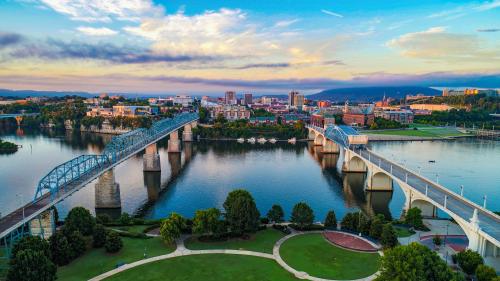
Commentary
Op-edThe Populist Threat to Putin’s Power
November 15, 2013